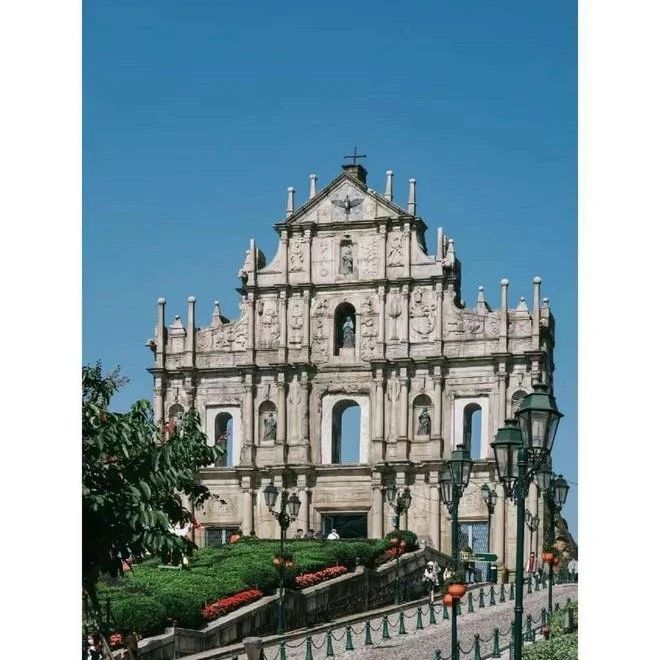Links Between East and West 59 - Macau 东西方的连接59 - 澳门
Introduction
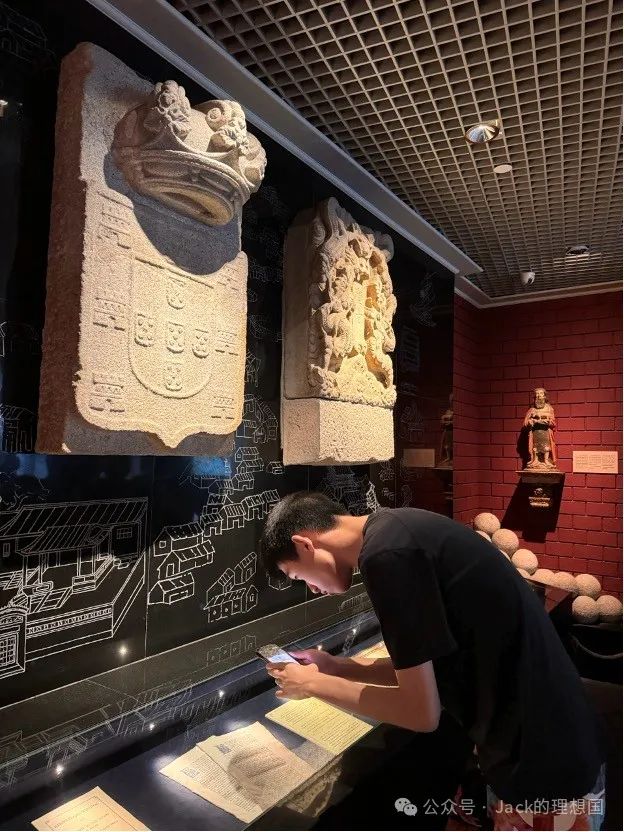
(The author visiting the Museum of Macau)
Today, Macau is often perceived as a city of wealth and fame - the “Las Vegas of the East.” It is a bustling metropolis that never sleeps, with towering skyscrapers and casinos that can either elevate one to the heavens or plunge them into despair. However, this image only captures a fraction of the city’s rich tapestry. A deeper exploration of Macau’s history reveals a cultural fusion that is not just unique but also unparalleled. Macau’s culture is a complex blend of traditional Chinese, Portuguese, and European influences, each contributing distinctively to the city’s diverse cultural landscape.
This article will comprehensively investigate Macau through a historical lens. It will comprise three sections, each offering a detailed and thorough overview of Macau's development. The first section provides a comprehensive overview of Macau’s history, from the early days of Chinese settlement to the colonial era and the modern twenty-first century after Portugal returned the city to China. This section will unveil Macau's history's sheer complexity and seeming irregularity. The second section will explain the history of Sino-Portuguese cultural exchanges occurring in Macau based on the content of the previous section. Such an explanation hopes to shed light on how cultural interactions have shaped Macau’s identity. Building on the content from the first two sections, the third section will broaden the scope of this essay. The author will explore and discuss the various relationships between the cultures of the colonizers and the colonized. This section will elaborate on the different factors that could affect the kind of relationship that both the colonizers and the colonized adopted.
Section 1: A Brief Overview of Macau’s History
Macau’s history is divided into three segments: Early history, the Portuguese colonial era, and the modern times after 1999.
Early History
People have inhabited Macau for thousands of years. The human history of Macau stretches back up to six millennia, with many prehistoric cultures dotting the Macau Peninsula. During the Qin Dynasty (221-206 B.C.E.), the region was governed by Panyu County of the province of Guangdong. However, at the time, the population was quite scarce. The central government could exert little direct and effective control over this island at the southern tip of China. Historical records show that people first settled in the region during the Han Dynasty (206 B.C.E.-220 C.E.). Its natural harbors and fertile land characterized the area. Therefore, the people survived by following a lifestyle of fishing and agriculture. Some historians speculate the coastal location allowed for occasional interaction and trade with neighboring regions, including other parts of what is now southern China and Southeast Asia. Like during the Qin Dynasty, direct administrative control over Macau was limited, though the Han government’s influence did extend to the southern coastal areas.
Archaeological evidence is sufficient to verify that merchant ships began to travel between Southeast Asia and modern-day Guangzhou during the fifth century. As a crucial port for refuge, fresh water, and food, Macau evolved into a regional nexus. The region received a sudden influx of inhabitants during the late Song Dynasty. In 1277, approximately 50,000 refugees fleeing the Mongol conquest of China settled along the Macanese coast, further solidifying Macau's role as a hub for cultural exchange.
As the population steadily grew, Macau’s traditional culture sprang to life. Buddhism was arguably the first religion to take root in Macau. In the Ming Dynasty (1368-1644 C.E.), fishermen from the modern-day Guangdong and Fujian Provinces migrated to Macau, introducing some of their “Minnan” religions.
The Portuguese Colonial Era
During the Age of Discovery, Portuguese sailors explored the coasts of Africa and Asia, aiming to find trade routes that connected Asia to Europe. In 1511, the Portuguese conquered Malacca, gaining access to the Malacca Strait through which they could travel to East Asia. Headed by the explorer Tomé Pires, the Portuguese first attempted to approach and take hold of the trading posts around Macau by force. They realized that Macau could be an indispensable link in the trade route from Korea, Japan, and the Southeast Asian islands to Africa and Europe. The Ming Chinese defeated the Portuguese twice at the Battles of Tunmen and Sincouwaan. After these defeats, the Portuguese switched their strategy. Instead of taking Macau by force, they negotiated with the Chinese government in 1554, signing the Luso-Chinese Agreement under which they rented Macau as a trading post from China by paying an annual lease. In 1557, the Ming court consented to a permanent and official Portuguese trade base at Macau, marking the start of an era of Portuguese de facto colonization.
During this period of colonization, the Portuguese introduced Western architecture, religion, and customs to Macau. They built churches and public buildings in distinctive European styles. The Portuguese attempted to take a more thorough grip on the colony by marrying local women and establishing missionary schools.
Modern Era
In 1986, the Chinese and Portuguese governments began to negotiate over the issue of handing over Macau. In 1987, both countries agreed that from December 20, 1999 onwards, Macau would be under the administration of China. As early as 1984, Deng Xiaoping, the Chinese leader at the time, proposed the “One Country, Two Systems” policy for Macau.
In 1999, Portugal handed Macau over to the PRC.
Section 2: Sino-Portuguese Exchanges and Macau’s Mixed Cultural Identity
The last section shows that Portugal's colonization of Macau was notably less violent and more peaceful than the European powers’ colonization of other parts of Africa and Asia, which often involved genocides of the indigenous population. This relatively peaceful process of colonization in Macau allowed for cultural exchanges between the Portuguese and the local Macanese population. One can consider four aspects – architecture, language, education, and religion – to visualize the cultural interactions between the two groups during the colonial era.

Macau’s buildings constitute the first aspect that vividly portrays Macau’s social diversity. The Portuguese introduced European architectural styles and structures, resulting in the construction of churches, fortresses, and public buildings. However, the Portuguese architectural style did not completely replace the Chinese style. Instead, a fusion of Chinese and Portuguese architectural elements emerged over time. One of the most notable buildings is the ruins of St. Paul’s Church, built by the Portuguese in 1637. The Church reflects a blend of European Baroque artistic elements and ancient Chinese elements. While the building contains traditional Western features such as columns, pediments, and statues of religious figures, it simultaneously presents conventional Chinese motifs such as the chrysanthemum and peony. The Church’s designers could fuse Eastern and Western elements due to Macau’s role as a major trade port between China and Europe, facilitating the exchange of cultural aspects regarding architecture alongside economic goods. Additionally, local Chinese artisans and builders took part in constructing many European-style buildings. Their craftsmanship and traditional techniques influenced the final appearance of these structures.
Aside from St. Paul’s Church, architecture from different cultures dotted Macau, from Christian churches or monasteries to Chinese courtyards to Buddhist and Minnan religious temples. Like Quanzhou, the diverse architectural styles suggest that Macau was a trade nexus, especially since the mid-sixteenth century. Traders from Southeast Asia and Europe found the trade so profitable that they settled in Macau, creating communities equipped with schools, churches, and other public facilities. Unlike some southern ports, such as Guangzhou or Quanzhou, foreign buildings, such as Portuguese ones, appeared more dominant in Macao. This pattern can be attributed to the role of the Portuguese as the middlemen in the popular trade routes. For example, one trade route connected modern-day Nagasaki to Guangzhou and Macau to Europe. The Portuguese shipped Chinese silk to Japan and Japanese silver to China and Europe, profiting considerably. Macau was the central piece in this trade route, allowing Portuguese sailors to offload some cargo, replenish food and water, and then travel to Japan or Europe. Thus, Macau was critical to the Portuguese, incentivizing them to build all kinds of public buildings for long-term living.
The second aspect that can demonstrate the interplay between various cultures in Macau is the spoken languages. Today, Macau's official languages are Chinese (Cantonese) and Portuguese. This fact in itself reflects the bilingual nature of the region and its history as an area populated by both the Chinese and Portuguese. However, historically, the Macanese spoke a creole language known as Patuá, which blends Portuguese, Malay, English, and Cantonese. Patuá is significant evidence for historians investigating the development and interactions between different cultures in Macau from the sixteenth to the early twentieth centuries. Patuá illustrates that Macau’s mixed culture may stem from more roots than just the Chinese and the Portuguese. Malay elements in the language suggest that Southeastern civilizations might have played a more significant role in the developmental course of Macau’s culture than what many assume. Similarly, including elements from English may imply that other European powers besides Portugal encountered local Macanese during the colonial era.
Moreover, Patuá has a rich literary and oral tradition that reflects cultural fusion. For instance, Cristóvão Vieira was a poet in the sixteenth century who wrote poetry in Patuá. His poems often blend Portuguese poetic forms with local themes and language, synthesizing European literary traditions with local sensibilities. Patuá is also rich in folktales and legends that combine European and Asian elements. Some stories feature supernatural beings as typical in Western narratives, while others, like many Chinese fables, offer moral lessons. The Macanese community's literary creations using Patuá reveal complex interactions between European colonizers and the local population. These texts and the language serve as cultural artifacts that illustrate the ingrained nature of these interactions in Macau’s culture.
A third aspect demonstrating Macau's cultural diversity is its educational institutions and systems. The Portuguese wanted to hold on to this colony for a prolonged period, so they set up many missionary schools to spread Christianity and establish a strong sense of community. Today, Macau still has fifteen missionary schools, many with a history of at least half a century. Some schools date back to as early as 1594, not long after the Portuguese first arrived in Macau. Although these missionary schools teach Western values principally, they have been situated on Chinese soil and inevitably influenced by Chinese culture. Historically, some schools recognized the irreplaceable status of Chinese in the local culture and, therefore, incorporated instructions in Chinese languages and even Chinese courses. Some even claim that Confucian values such as respect for elders, filial piety, and social harmony have been integrated into the educational philosophy of Western missionary schools in Macau. The missionary schools in Macau reflect the multiple cultures that mingled in history and how such intercultural mingling leaves impacts that may be seen today.
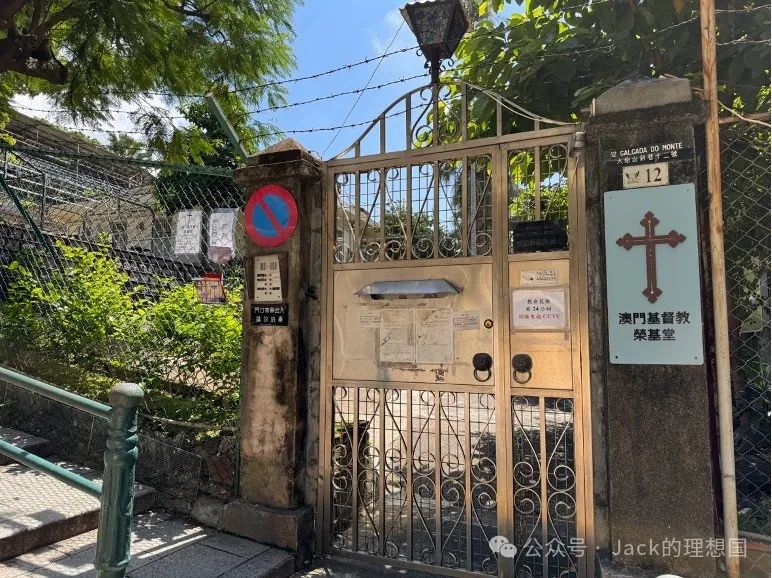
A final aspect that helps portray Macau’s mixed cultural identity is the coexistence of religions. Portuguese missionaries, particularly Jesuits, established a solid Catholic presence as a Portuguese colony to provide a historical context. However, most of Macau’s population has always been ethnically Chinese, bringing with them traditional Chinese religions such as Buddhism. The city has a diverse religious landscape. There are various Catholic churches and institutions, the aforementioned St. Paul’s Church being a prime example. Alongside Christian churches are Buddhist temples and the gods and goddesses of the Minnan religions. The city also contains smaller communities of other faiths, including Hinduism, Islam, and Judaism, reflecting its mixed cultural identity.
Historically, owing to its role as a trade hub, Macau has had relatively greater religious freedom. Historical records show few major purges or persecution movements against any religion. Presently, Macau still hosts various religious communities, and many buildings belonging to different religions are still in use. Macau's religious tolerance and relative harmony have shaped a multifaceted culture, serving as a testament to the city’s historical significance as an economic and cultural crossroads.
Section 3: The Various Relationships Between the Colonizers and the Colonized
Macau’s history begs the question: What relationships could have developed between the colonizers and the colonized, and what factors might have determined which relationship the two sides adopted? To seek an answer, one must look beyond the borders of Macau. Three primary relationships might grow within a colony. The first is colonial dominance, whereby the colonizers’ culture engulfed that of the colonized; the second is fusion, whereby the cultures of the two sides mingled with each other and adopted values and practices from the other; and the third and last is resistance, whereby the traditional culture of the colonized “ousted” that of the colonizers.
The nature of the colonial administration is one factor that could help determine the relationship between the colonizers and the colonized. This factor is important because often, the colonizers were more dominant in power than the colonized. This means that the colonizers’ governments might possess more significant sway over the fate of the colonized and, hence, the relationship with them. One parameter that historians can use to ascertain the nature of a colonial administration is the level of interference – the extent to which the colonizers interfered in local governance, education, and religion.
In the short run, the greater the level of interference, the more likely there would be cultural dominance, whereby the cultural values of the colonized succumbed to those of the colonizers. For instance, the French policies in Algeria during the nineteenth century significantly interfered. French was made the official language, the French legal system was imposed, and French cultural institutions were established. As a result, the Algerian language, educational system, and cultural institutions either disappeared or gave way to the efforts of the French. In the short term, Algerian culture merged with that of the French. For Macau, the nature of the colonial administration was less interfering. As a result, the Portuguese had a relatively lesser dominance over the local one. The Portuguese and local Macanese cultures fused more, as demonstrated above.
A second factor that could determine the relationship between the colonizers and the colonized is the duration of colonization. The effects of time on the culture of a colony are more complex. One can argue that the longer the colonization, the more possible the local culture would succumb to the colonizing culture (the first relationship – colonial dominance). Conversely, the counterargument that long periods of colonization might ferment an effective resistance from the local culture (the third relationship – resistance) also possesses merit, the case of India and the British Empire being a fitting example. Long periods of subjugation by the British led to nonviolent movements and the organization of revolutionary groups to engage in acts of armed resistance. There is even a third possibility that as time passed, the colonized and the colonizers learned to coexist side-by-side. Thus, their cultural values fused. The Portuguese married local women in Macau, facilitating long-term interactions and blending different values and conventions.
Further, the economic relationship within a colony often plays an underestimated role in shaping the cultural relationship between the conquerors and the conquered. A more intertwined economic relationship with interdependence could accelerate cultures' fusion. The Portuguese partially relied on the Chinese for trading purposes in Macau. As a result, both sides learned the other’s language and business practices, permitting more integral interactions between their cultures. In contrast, for a colony in which the colonizers’ economic purposes were only to reap resources and enslave the locals, then the culture of the colonized would simultaneously be subjugated. When the Spanish Empire made its early conquests in Central America during the sixteenth century, driven by their desire to loot the natural resources there, the Spanish imposed their culture and exterminated that of the natives.
Finally, the strength and resilience of the native culture partly helped define the relationship between the cultures of the colonizers and the colonized historically. Societies with strong, deeply rooted cultural traditions and social structures are likelier to retain their cultural identity. Despite periods of foreign influence, the colonies of China have maintained their cultural identities relatively more effectively. This success might be attributed to the resilience of the Chinese culture, having long-lasting philosophical foundations, literature, art, and a unified language. In many cases, the Chinese culture defended itself against foreign invading cultures due to its inherent strength. A culture's strength would impact its adaptability, allowing it to integrate foreign elements without losing its core identity.
Conclusion
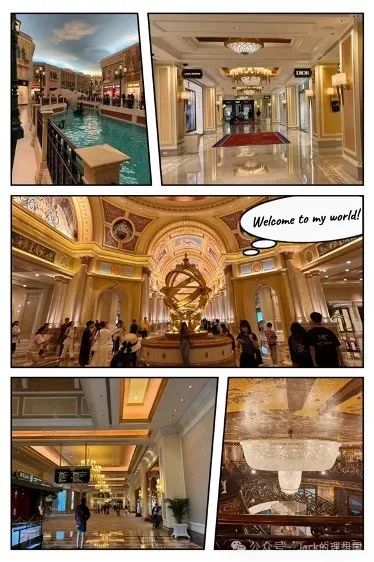
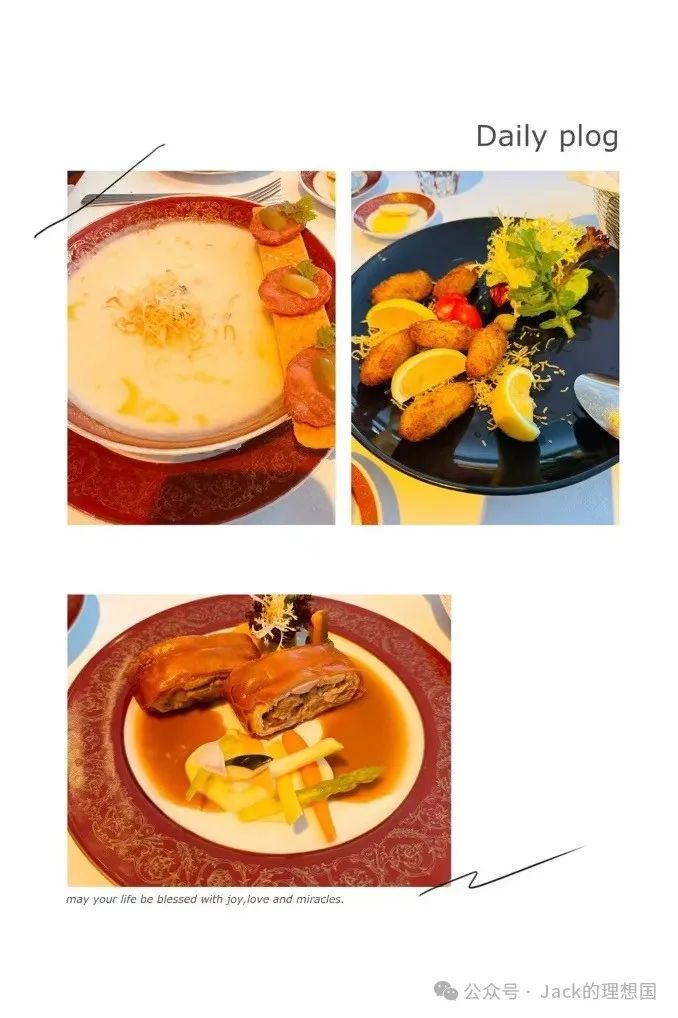
The impact of this cultural fusion can be seen in every corner of Macau, from its unique architecture to its rich culinary traditions. Today, Macau is where the past intertwines with the present in a harmonious blend of traditions. As visitors wander through the old city's narrow streets, they are met with a vivid tapestry of history, where Eastern and Western influences converge to create a vibrant and dynamic cultural landscape. Macau's journey from a humble fishing village to a global melting pot is a story of resilience, adaptability, and the transformative power of cultural exchange.
澳门简介

(作者参观澳门博物馆)
如今,澳门常常被视为财富与名声之都--"东方的拉斯维加斯",一座不夜城。然而,这样的描述仅仅捕捉到了这座城市丰富多彩面貌的一小部分。深入探究澳门的历史,就会发现澳门的文化融合不仅独一无二,而且富有历史的韵味。澳门的文化复杂地融合了中国传统文化、葡萄牙文化和欧洲文化,每一种文化都为澳门的多元文化景观做出独特的贡献。
本文将从历史的角度全面探究澳门。文章由三个部分组成,每个部分都将对澳门的历史沿革与发展作详细而全面的概述。第一部分介绍澳门的历史,从早期中国人定居时代到殖民地时期,再到葡萄牙将澳门归还中国后的二十一世纪。这部分将揭示澳门历史的复杂性和不规则性。第二部分将在前一部分内容的基础上,解释澳门的中葡文化交流情况,希望能够揭示文化交流如何塑造了澳门的多元文化身份。在前两部分内容的基础上,第三部分将扩大文章的讨论范围,作者将探讨殖民者和被殖民者文化之间的各种关系。这一部分将阐述可能影响这些关系的不同因素。
第一部分:澳门历史简介
澳门的历史分为三个部分:早期历史、葡萄牙殖民时代与1999年后的现代历史。
早期历史
澳门有数千年的历史。澳门的人类史前时期可追溯至六千年前,许多史前文化遍布澳门半岛。在秦朝(公元前221-206 年)时代,澳门地区由广东省番禺县管辖。然而,当时人口稀少,中央政府对这个位于中国南端的岛屿几乎无法实施直接有效的控制。史料记载,汉代(公元前 206 年-公元前 220 年)就有人在此定居。该地区的特点是拥有天然良港与肥沃的土地,因此,人们以捕鱼和务农为生。一些历史学家推测,由于地处沿海,该地区偶尔会与邻近地区(包括现在的中国南部和东南亚其他地区)进行交流和贸易。与秦朝一样,汉朝政府对澳门的直接行政控制是有限的,但其影响力确实延伸到了南部沿海地区。
考古证据足以证明,五世纪时,商船开始往来于东南亚和今广州之间。作为避难所、淡水和食物的重要港口,澳门逐渐发展成为一个地区中心。宋朝末年,大量居民涌入澳门,1277年,约5万名逃离蒙古铁骑的难民在澳门沿岸定居,进一步巩固了澳门作为经济文化交流中心的地位。
随着人口的稳步增长,澳门的传统文化也焕发出勃勃生机。佛教可以说是最早在澳门扎根的宗教。明朝(公元1368-1644年),来自广东和福建的渔民移居澳门,并引入了闽南当地宗教。
葡萄牙殖民时代
"大航海时代",葡萄牙水手探索非洲与亚洲海岸,旨在寻找连接亚洲与欧洲的贸易路线。1511 年,葡萄牙人征服了马六甲,获得了通往东亚的马六甲海峡的通行权。在探险家托梅-皮雷斯(Tomé Pires)的带领下,葡萄牙人首先试图用武力接近并占领澳门周围的贸易站。他们意识到,澳门可能是朝鲜、日本和东南亚岛屿通往非洲和欧洲的贸易路线上不可或缺的一环。明朝中国势力在屯门战役中击败葡萄牙人,促使他们改变战略。1554 年,他们没有用武力夺取澳门,而是与中国政府谈判,签署了《中葡澳门条约》,根据该协定,他们每年向中国支付租约,租用澳门作为贸易站。1557 年,明朝朝廷同意葡萄牙在澳门建立永久性官方贸易基地,标志着葡萄牙殖民时代的开始。
在这段殖民时期,葡萄牙人将西方的建筑、宗教与习俗引入澳门。他们建造了具有独特欧洲风格的教堂和公共建筑,且试图通过与当地妇女结婚,建立传教士学校来更彻底地控制此殖民地。
现代
1986年,中葡两国政府开始就澳门的移交问题进行谈判。1987年,中葡两国同意从1999年12月20日起,澳门由中国管辖。早在1984年,当时的中国领导人邓小平就提出了 "一国两制 "的澳门政策。1999 年,葡萄牙将澳门移交给中华人民共和国。从那时起,澳门继续秉承其多元文化传统,同时与中国大陆更加紧密地融合在一起。随着基础设施和娱乐业的快速建设,澳门的经济也实现了腾飞。
第二部分:中葡交流与澳门的混合文化身份
上一部分显示,与欧洲列强在非洲和亚洲其他地区的殖民统治相比,葡萄牙在澳门的殖民统治显然没有那么暴力,更加和平。澳门相对和平的殖民化进程使葡萄牙人与澳门当地居民得以进行文化交流。史学家可以从建筑、语言、教育和宗教这四个方面来观察殖民时期两个群体之间的文化交流。
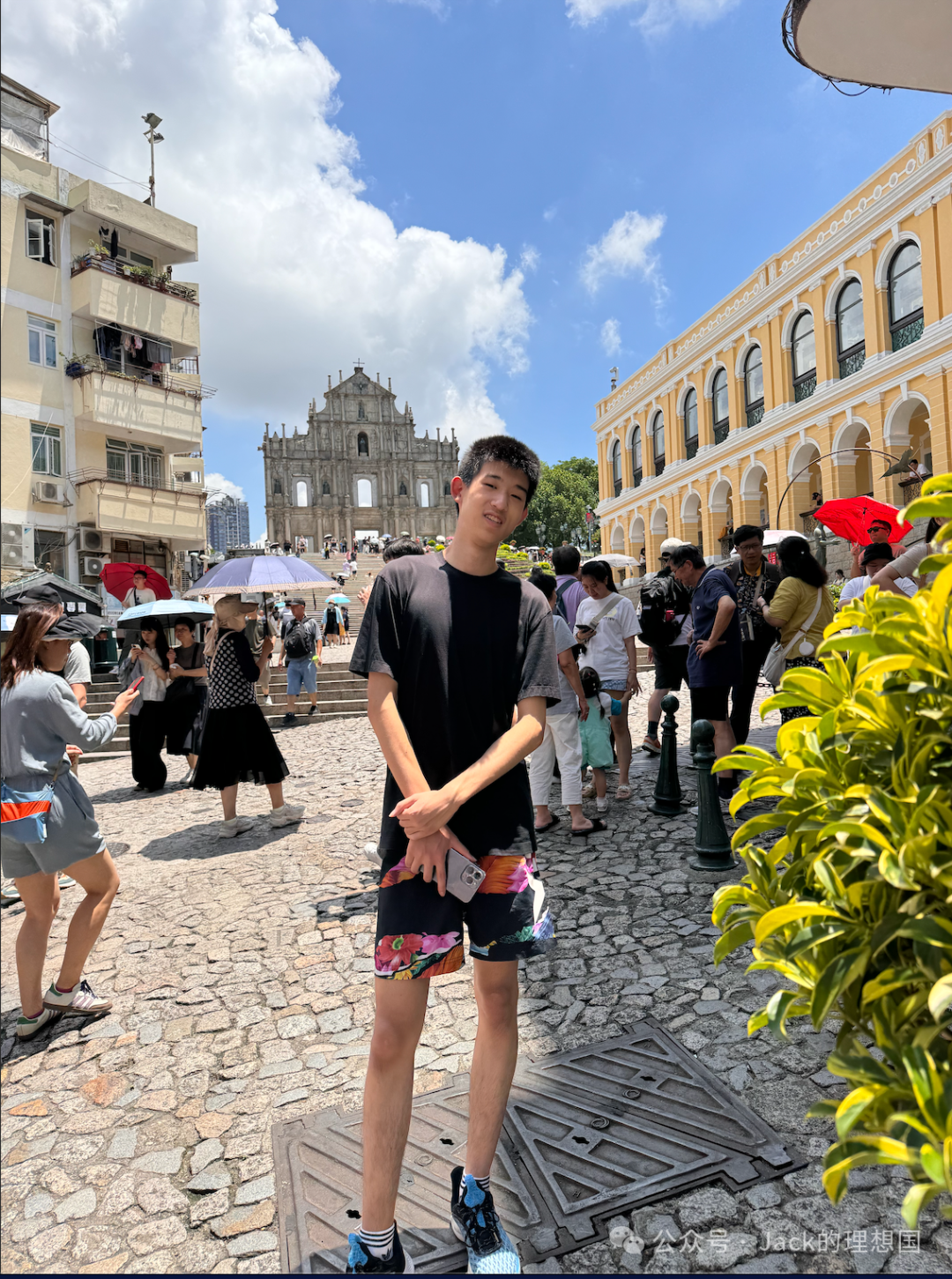
(作者在圣保罗教堂遗址前)
澳门的建筑是生动描绘澳门社会多样性的第一个方面。葡萄牙人引进了欧洲的建筑风格和结构,建造了教堂、堡垒、公共建筑。然而,葡萄牙建筑风格并没有完全取代中国风格,相反,随着时间的推移,中葡建筑元素逐渐融合。最著名的建筑之一是葡萄牙人于 1637 年建造的圣保罗教堂遗址。该教堂体现了欧洲巴洛克艺术元素与中国古代元素的融合。虽然该建筑包含传统的西方特征,如圆柱、花饰及宗教人物雕像,但同时也呈现了传统的中国图案,如菊花或牡丹花纹。由于澳门是中国和欧洲之间的主要贸易港口,这样的城市身份促进了建筑文化与经济商品的交流,因此教堂的设计师能够融合东西方元素。此外,当地的中国工匠和建筑工人也参与了许多欧式建筑的建造,他们的手工艺与传统技术影响了这些建筑的最终外观。
除了圣保罗教堂遗址外,不同文化背景的建筑也遍布澳门,从基督教堂或寺院到中式庭院,再到佛教与闽南妈阁庙。与泉州一样,多样的建筑风格表明澳门是一个贸易枢纽,特别是自十六世纪中叶以来,来自东南亚和欧洲的商人发现贸易利润丰厚,于是在澳门定居下来,建立了配备学校、教堂与其他公共设施的社区。与广州、泉州等南方港口不同,澳门的外来建筑,如葡式建筑,占主导地位。这种情况可归因于葡萄牙人在热门贸易路线中扮演的中间商角色。例如,有一条贸易路线将现代长崎与广州、澳门、欧洲连接起来。葡萄牙人将中国的丝绸运往日本,将日本的白银运往中国和欧洲,从中获利颇丰。澳门是这条贸易路线的核心,葡萄牙水手可以在澳门卸下一些货物,补充食物和水,然后前往日本或欧洲。因此,澳门对葡萄牙人至关重要,促使他们为长期生活建造各种公共建筑。
第二个方面可以说明澳门不同文化之间的相互影响是语言。今天,澳门的官方语言是中文(广东话)与葡文。这一事实本身就反映了该地区的双语性质及其作为中国人和葡萄牙人聚居区的历史。然而,在历史上,澳门人讲一种混合了葡萄牙语、马来语、英语和粤语的融合语,即 "巴都亚语",澳门土语。对于研究十六世纪至二十世纪初澳门不同文化之间的发展和互动的历史学家来说,这门语言是重要的证据。澳门的混合文化可能不仅仅源于中国和葡萄牙。这门语言中的马来语元素表明,东南文明在澳门文化的发展过程中扮演的角色可能比许多人想象的更为重要。同样,加入英语元素可能意味着,在殖民时代,除葡萄牙外,其他欧洲列强也曾接触过澳门本地人。
此外,澳门土语拥有丰富的文学和口头传统,反映了文化的融合。例如,克里斯托旺-维埃拉(Cristóvão Vieira)是十六世纪用这门语言写诗的诗人,他的诗歌经常将葡萄牙诗歌形式与当地主题和语言相结合,将欧洲文学传统与当地情感融为一体。用土语创作的民间故事和传说内容也同样丰富,融合了欧洲、亚洲的元素。一些故事以西方叙事中典型的超自然元素为主题,而另一些故事则与许多中国寓言一样,具有极为深刻的道德寓意。澳门人利用土语创作的文学作品揭示了欧洲殖民者与当地居民之间复杂的互动关系。这些文本和语言作为文化艺术品,说明了这些互动在澳门文化中根深蒂固的性质。
显示澳门文化多样性的第三个方面是澳门的教育机构与教育体系。葡萄牙人希望长期占据这块殖民地,因此设立了许多传教士学校,以传播基督教和建立强烈的社区意识。今天,澳门仍有 15 所传教士学校,其中许多学校至少有半个世纪的历史。有些学校的历史可以追溯到 1594 年,也就是葡萄牙人初到澳门不久。虽然这些传教士学校主要教授西方价值观,但由于地处中国,不可避免地受到中国文化的影响。历史上,一些学校认识到中文在当地文化中不可替代的地位,因此将中文教学甚至中文课程纳入其中。有人甚至声称,儒家价值观,如尊敬长辈、孝顺父母、社会和谐等,已融入澳门西方传教士学校的教育理念中。澳门的传教士学校反映了历史上多种文化的交融,以及这种跨文化交融如何留下了在今天仍然能被目睹的影响。
(澳门街区中的基督教教堂)
有助于描绘澳门混合文化特征的最后一个方面是宗教的共存。作为葡萄牙殖民地,葡萄牙传教士,特别是耶稣会士,在澳门建立了稳固的天主教势力,为澳门提供了历史背景。然而,澳门的大部分人口一直是华裔,他们带来了佛教等中国传统宗教。澳门拥有多元化的宗教景观,有各种天主教堂和机构,前面提到的圣保罗教堂就是一个贴切的例子。除基督教堂外,还有佛教和闽南宗教的诸神,市内还有其他信仰的小社区,包括印度教、伊斯兰教和犹太教,反映了其混合的文化特征。
历史上,由于澳门是贸易枢纽,宗教信仰相对是自由的。历史记录显示,澳门很少发生针对任何宗教的大迫害运动。目前,澳门仍有各种宗教团体,许多属于不同宗教的建筑物仍在使用。澳门的宗教宽容和相对和谐造就了多元文化,也证明了澳门作为经济和文化交汇点的历史意义。
第三部分:殖民者与被殖民者之间的关系
澳门的历史提出了一个问题: 殖民者与被殖民者之间可能发展出何种关系,哪些因素可能决定了双方采取何种关系?要寻找答案,我们必须同时把目光投向澳门以外的地方。在大多数殖民地内殖民者与被殖民者可能会发展出三种主要关系。第一种是绝对统治,即殖民者的文化吞噬了被殖民者的文化;第二种是融合,即双方的文化相互交融,并采用对方的价值观和习俗;第三种也是最后一种是抵抗,即被殖民者的传统文化 "驱逐 "殖民者的入侵文化。
殖民管理机构的性质是参与确定殖民者与被殖民者之间关系的一个因素。这一因素之所以重要,是因为殖民者往往比被殖民者更有权力。这意味着殖民者的政府可能对被殖民者的命运有更大的影响力,因此也会影响与被殖民者关系的建立。历史学家可以用来确定殖民政府性质的一个方面是干预程度--殖民者对当地治理管辖、教育和宗教的干预程度。
从短期来看,干预程度越高,就越有可能出现文化主导,即殖民者的文化价值观吞噬被殖民者的文化价值观。例如,19 世纪法国在阿尔及利亚的政策就进行了大量干预。法语被定为官方语言,法国的法律制度被强加于人,法国的文化机构被建立起来。结果,阿尔及利亚的语言、教育体系和文化机构要么消失,要么在法国人的努力下让位。在短期内,阿尔及利亚文化与法国文化融为一体。就澳门而言,殖民政府的干预较少,因此,葡萄牙人对本地人的支配力相对较弱,如上所述,葡萄牙文化与澳门本地文化的融合程度较高。
决定殖民者与被殖民者之间关系的第二个因素是殖民时间的长短。时间对殖民地文化的影响更为复杂。有人认为,殖民时间越长,当地文化就越有可能屈服于殖民文化(第一种关系—殖民文化主导)。反之,长期的殖民化可能会使当地文化产生有效的抵抗(第三种关系--抵抗),这种反驳也有其道理,印度和大英帝国就是一个恰当的例子。英国人的长期征服导致了非暴力运动与组织革命团体进行武装抵抗。甚至还有第三种可能,即随着时间的推移,殖民者与被殖民者学会了并肩共存,他们的文化价值观发生了融合。葡萄牙人在澳门与当地妇女结婚,促进了长期交往,融合了不同的价值观和习俗。
此外,殖民地内部的经济关系在塑造征服者与被征服者之间的文化关系方面所起的作用往往被低估。相互依存的经济关系可以加速文化的融合。葡萄牙人在澳门的贸易部分依赖于中国人,因此,双方都学习了对方的语言和商业惯例,使双方文化之间的互动更加完整。相反,如果殖民者的经济目的只是获取资源和奴役当地人,那么被殖民者的文化也会同时被征服。16 世纪,西班牙帝国早期征服中美洲时,为了掠夺当地的自然资源,西班牙人将自己的文化强加给当地人,并灭绝了当地人的文化。
最后,本土文化的力量和韧性在一定程度上帮助确定了殖民者文化与被殖民者文化之间的历史关系。拥有强大、根深蒂固的文化传统与结构的社会更有可能保持其文化特性。中国的殖民地虽然也曾受到过外来文化的影响,但相对而言,它们更有效地保持了自己的文化身份。这种成功可能要归功于中国文化的韧性,它拥有持久的哲学基础、文学、艺术和统一的语言。在许多情况下,中国文化凭借其固有的力量抵御外来文化的入侵。一种文化的力量会影响其适应性,使其能够在融入外来元素的同时不丧失其核心特征。
结论
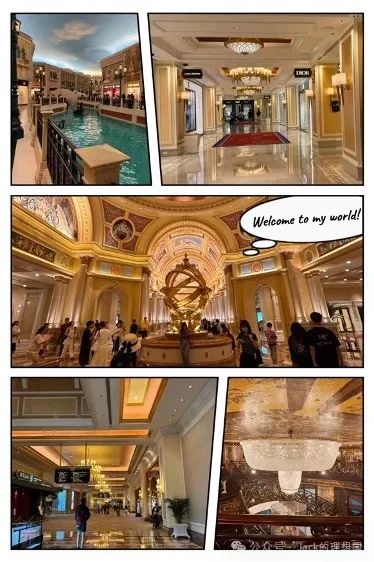
本文通过三个部分深入探讨澳门:第一部分概述了澳门的历史,从早期华人定居时期到殖民地时期,再到葡萄牙统治后的二十一世纪。第二部分阐释了中葡文化交流,强调了文化互动如何塑造了澳门的身份。最后,第三部分通过讨论殖民者和被殖民者文化之间的各种关系,扩大了本文的范围,这一部分还详细介绍了影响这种文化关系的不同因素。
这种文化融合的影响体现在澳门的每个角落,从独特的建筑到丰富的饮食传统。今天的澳门,过去与现在交织在一起,传统与现代和谐交融。当游客漫步在澳门老城区狭窄的街道上时,映入眼帘的是一幅生动的历史画卷,东西方文化在这里交汇,形成了一幅生机勃勃的文化景观。澳门从一个微不足道的小渔村发展成为一个全球文化大熔炉的历程,是一段关于从历史至现今文化交流的变革力量的史诗故事。
- 本文标签: 原创
- 本文链接: http://www.jack-utopia.cn//article/640
- 版权声明: 本文由Jack原创发布,转载请遵循《署名-非商业性使用-相同方式共享 4.0 国际 (CC BY-NC-SA 4.0)》许可协议授权
